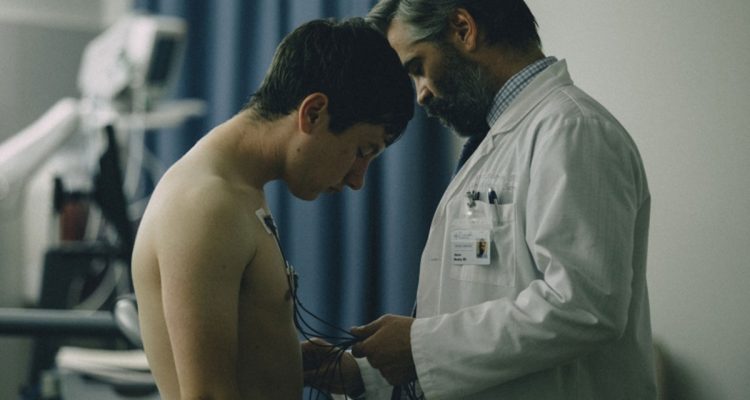This is a reprint of our review from the 2017 Cannes Film Festival.
Maybe the second or third shot in Yorgos Lanthimos‘ “The Killing of a Sacred Deer” is of a hospital waste bin, over which Colin Farrell, as heart surgeon Steven Murphy, peels off his bloodied latex gloves post-surgery. Now, if you hold simultaneously in your head the established ideas of the surgeon-as-God and the director-as-God, then that suggests the surgeon equates to the director, and gives us a neat metaphor. “The Killing of a Sacred Deer” is Lanthimos with the gloves off, and it makes the absurd, amazing “The Lobster” seem like a warm and cuddly experience by comparison. A film of clean hands, cold heart, and near-Satanic horror, it was garlanded with boos at its Cannes press screening and it is absolutely fucking brilliant.
Part of what makes its deep-freeze, suburban soul-sickness so effective is that, although the studied formalism, deterministically stiff performance style and deliberately flat line readings are instantly recognizable Lanthimosian traits, the film is set in a world that’s only a plate-glass sliver of weirdness away from our own. This is not the contained universe of “Dogtooth” (which it most closely resembles in the director’s back catalogue), nor the alternate reality of “The Lobster.” Instead, while Thimios Bakatakis‘ crisp, creeping camerawork and the atonal, anti-melodic sound design from Johnnie Burns (“Under the Skin“) turn the thermostat setting to “ice age,” there’s recognizable real life here: diners, traffic, backyard barbecues, and school principal’s offices. And there is also a house — the big, statement-staircased house of a successful, moneyed professional couple — and a hospital, down whose vanishing-point corridors the camera glides so precisely, it’s like the Overlook Hotel had a medical makeover.
READ MORE: ‘Killing Of A Sacred Deer’: Colin Farrell Talks Teenage Hormones In First Clip [Watch]
Cardiologist Steven Murphy has an opthalmologist wife, Anna, who is played by Nicole Kidman, appropriately bringing the Jonathan Glazer and Stanley Kubrick comparisons to life by delivering an icily immense performance somewhere between her turns in “Birth” and “Eyes Wide Shut.” Steven and Anna have two children, the 14-year-old Kim (Raffey Cassidy) whom we’re flatly informed “started menstruating last week,” and the 12-year-old Bob (Sunny Suljic), whose long hair is a source of irritation to his father. Steven has also secretly been meeting the 16-year-old Martin (Barry Keoghan, remarkable) on an increasingly regular basis: for a time we don’t know why, but we can read the lines of their interactions enough to know that Steven feels an obligation toward him. Martin, who lives with his mother (Alicia Silverstone, so good in her small role), seems to receive Steven’s attentions with humble gratitude.
“Such a nice boy,” confirms Anna after Steven finally introduces Martin to the family. Certainly Kim agrees, responding to Martin’s off-centre sincerity and strangeness the only way a teenage girl knows how: by developing a crush on him. But Martin’s intentions turn out to be less than benign, to put it mildly. And from there, with infinite patience, and terrible, meticulous anti-logic Lanthimos (and regular co-writer Efthimis Fillipou) leads us inexorably to a climax in which, unusually, the absurdity does not take any of the edge off the nastiness. Is this cinema, or is this psyop?
Farrell is again tremendous, having found a rhythm with Lanthimos on “The Lobster” (nobody uses Farrell’s facility with a pregnant pause better) yet bringing, within that same non-naturalistic register, a totally different character to life. But then, all the performances are note-perfect: hard-edged and brittle. And the revelation this time out is definitely Irish actor Keoghan in the film’s most pivotal and complex role. His Martin is both prosaically, banally normal and grandly, ambiguously mystical: a quasi-supernatural entity in sneakers, eating spaghetti.
It’s already divisive, and there’s no chance it will stop being so once it gets out there into the world. For those not on Lanthimos’ wavelength already it might well be unendurable: the drip-feed pacing; the despairing underlying view of humanity’s basic selfishness, even when it comes to their own kin; the cold-blooded emotionlessness. But for Lanthimos fans, it might just be the purest, and most dangerous hit of our favorite drug yet, with layers of potential dark significance and meta-meaning to almost every moment, from the dissociated kink of the sex scenes to the very “Dogtooth”-y evocation of the family unit as a kind of charismatic cult.
As many readings as there are, the dissonance between the cerebral and the visceral is an ongoing throughline, as it must be in any film that features someone biting a chunk out of their own arm and spitting it out, saying “It’s a metaphor!” But even as an experiment in the body/mind disconnect, it has a frighteningly caustic morality to it: buried under all that glacial ice there’s a withering portrait of suburban alienation and the surface-level equanimity of privilege. As atomized and insulated as we might think ourselves, the film seems to be saying, our actions have effects, our lives and choices can collide with those of others, and some invisible greater balance can be upset. The uncanniness of “The Killing of a Sacred Deer” is simply what happens when this beyond-our-ken tally of cosmic justice is made visible, given form; when it shows up at your door with a bunch of flowers and you invite it in, with all its attendant annihilation. [A]

